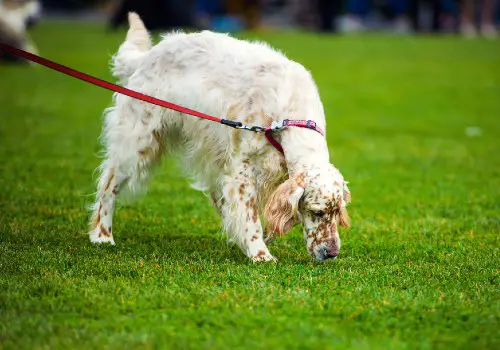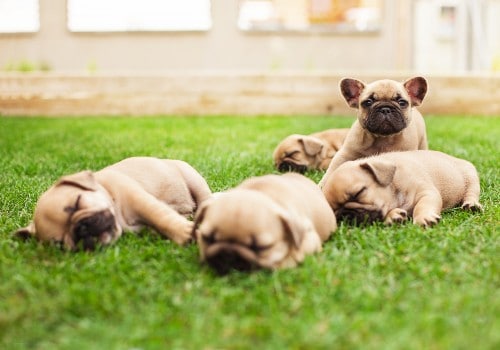We expect cows, horses and sheep to chow down on any grass they come across. But your dog?
As strange as it seems for your meat-loving pup to munch on your lawn, this behavior is surprisingly common. Something about grass makes some dogs’ appetites go wild, and if yours is one of them, you’re probably wondering why.
You’ve heard that grass makes dogs throw up, that dogs seek it out when they’re malnourished and that it’s totally harmless. So what’s the truth about dogs and grass, and what should you do next time your dog spots a tasty-looking patch?
Let’s solve this mystery and put those worries to rest — it’s been a “lawn” time coming!
Greener Generations

Some speculate that the relationship between dogs and grass goes way back — tens of thousands of years, in fact, before domestication.
Back then, dogs survived mainly by hunting and scavenging kills left behind by other predators. Herbivorous animals like deer, bison and horses were popular targets.
These prey animals were grazers who spent much of their day eating grass. When ancient dogs took one down, the animal’s stomach was inevitably full of recently-ingested grass.
And when the dogs devoured their prey, that grass got devoured along with the meat.
The theory goes that over time, dogs not only got used to the extra seasoning, but they also developed a taste for it. They began eating grass on its own as a snack, appetizer or dessert, and they passed that behavior down through the generations.
We can see evidence of this theory in the wild. Stool samples indicate that up to 47% of modern wolves eat grass, and several other species of wild dogs have been observed to graze.
A Balanced Diet
A dog’s body is a finely-tuned machine, and if it lacks in a certain nutrient or mineral, the dog instinctively seeks out foods that contain what it’s missing. The grass isn’t the first thing we think of when we picture nutritious foods, but it does contain a few vital nutrients, like calcium, iron, and selenium
The problem is that grass is mostly cellulose, which is very difficult to digest, so dogs can’t unlock many of those minerals. But cellulose itself has a nutritional benefit: it’s fiber, which aids in digestion.
Dogs who don’t get enough fiber in their main diet experience various forms of gastrointestinal distress, including upset stomach, constipation, nausea, gas, and diarrhea.
It’s thought that when a dog experiences these symptoms as a result of fiber deficiency, his instinct is to munch on some grass to get his digestive system going again.
Throw It Up
Similarly, when a dog eats something he shouldn’t have — some spoiled food, a dead animal, or a random poop from the ground — he might feel a little queasy. Rather than wait for whatever he ate to pass through his body, which could take hours and cause even worse discomfort, he’d rather vomit it back up and get on with his day.
And one easy way to do that is to eat some grass.
Grass, especially when swallowed whole, has a tickling effect on your dog’s tongue, mouth, throat, and stomach. This sensation can induce vomiting, similar to how some people vomit when they brush the backs of their tongues.
So when people say that grass makes dogs vomit, they’re not saying that it’s bad or poisonous for them to eat. Rather, they’re saying that eating grass is a way for dogs to self-induce vomiting when they feel the need to get something nasty out of their stomachs.
A Cure for Boredom

Boredom can make any animal go little nuts, as you may have noticed when you left your dog at home alone and returned to chewed-up shoes and half-eaten toilet paper rolls. For some dogs, “going nuts” in this regard means heading outside to graze on some grass.
Maybe your dog actually finds the act of eating grass a little fun, or maybe it’s just better than sitting around doing nothing. Either way, grazing may be his way of passing the time when there’s nothing else to do.
Gourmet Grazing
And finally, there’s the simplest explanation: your dog just likes the way grass tastes.
It could be a lot worse; some dogs crave socks, poop, rocks, or other things that are decidedly non-edible. Grass, at least, is an edible plant that’s readily available and usually harmless.
As long as the grass hasn’t been treated with pesticides, fertilizers, or other chemicals, it’s safe for your dog to eat. But it’s a good idea to check for large sticks, rocks, and other choking hazards before letting him chow down, especially if he’s a voracious eater.
And if you don’t want your grass-loving dog eating your whole lawn up, consider planting a tray of grass just for his enjoyment. You could also try giving your dog fresh vegetables, like lettuce and green beans, as treats to satisfy his craving for greenery.
